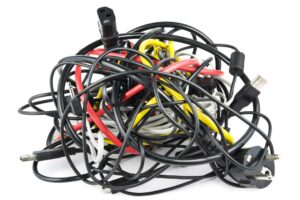Cables
Cables contain rare, valuable raw materials that can be processed into new products.
With every new smartphone, tablet or notebook – in fact with every electrical device – a new cable is supplied. Most of them comply with a standard and also fit other devices in your own household.
Correct dispose of used cables
Cables contain valuable raw materials: For example, copper can be found in many older models. This is because it is particularly conductive and hardly corrodes. Nowadays, aluminium is often used because it is lighter and cheaper to buy.
- When buying a new appliance, look for standardised cables so that you do not need new cables for every purchase.
- Keep cables that work. If a cable from another device breaks, it may be easy to replace it.
These raw materials are not only scarce and expensive, their extraction is often accompanied by the destruction of habitats for plants and animals. Working conditions in the mining of metals are also often poor. Therefore, the correct recycling of cables helps to protect the environment and save scarce resources.
During recycling, the wires in the cables are first separated from the sheath in several steps. Afterwards, plastic and metal are sorted and recycled according to various methods, for example via their density or using magnetism. In the metal smelters, they are used to manufacture new products. The plastics from the casing are usually thermally recycled.
Individual cables or cable remnants also belong to e-waste and are accepted via the Resources Center and Ecotrel‘s partners.

Cables
Cables contain rare, valuable raw materials that can be processed into new products.
With every new smartphone, tablet or notebook – in fact with every electrical device – a new cable is supplied. Most of them comply with a standard and also fit other devices in your own household.
Correct dispose of used cables
Cables contain valuable raw materials: For example, copper can be found in many older models. This is because it is particularly conductive and hardly corrodes. Nowadays, aluminium is often used because it is lighter and cheaper to buy.
- When buying a new appliance, look for standardised cables so that you do not need new cables for every purchase.
- Keep cables that work. If a cable from another device breaks, it may be easy to replace it.
These raw materials are not only scarce and expensive, their extraction is often accompanied by the destruction of habitats for plants and animals. Working conditions in the mining of metals are also often poor. Therefore, the correct recycling of cables helps to protect the environment and save scarce resources.
During recycling, the wires in the cables are first separated from the sheath in several steps. Afterwards, plastic and metal are sorted and recycled according to various methods, for example via their density or using magnetism. In the metal smelters, they are used to manufacture new products. The plastics from the casing are usually thermally recycled.
Individual cables or cable remnants also belong to e-waste and are accepted via the Resources Center and Ecotrel‘s partners.







